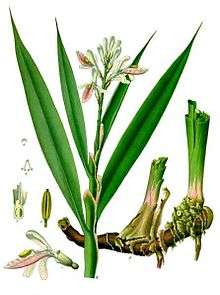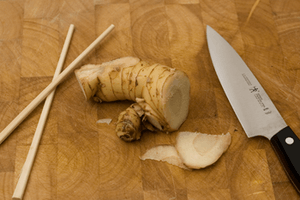Galangal
Galangal (/ˈɡæləŋˌɡæl/[1]) is a common name for several tropical rhizomatous spices.



Differentiation
The word galangal, or its variant galanga, can refer in common usage to the aromatic rhizome of any of four plant species in the Zingiberaceae (ginger) family, namely:
- Alpinia galanga, also called greater galangal, lengkuas or laos
- Alpinia officinarum, or lesser galangal
- Boesenbergia rotunda, also called Chinese ginger or fingerroot
- Kaempferia galanga, also called kencur, black galangal or sand ginger
Uses
Various galangal rhizomes are used in traditional Southeast Asian cuisine, such as Thai and Lao tom yum and tom kha gai soups, Vietnamese Huế cuisine (tré) and throughout Indonesian cuisine, as in soto. Polish Żołądkowa Gorzka vodka is flavoured with galangal. While all varieties of galangal are closely related to common ginger, and all exhibit some resemblance to the hot, spicy flavor of ginger, each is unique in its own right, and galangals are not typically regarded as synonymous with ginger or each other in traditional Asian dishes.
In ethnobotany, galanga has medicinal effects as it promotes digestion and alleviates respiratory diseases and stomach problems. Each galangal variety is attributed with specific medical virtues.[2][3]
In commerce, galangals are commonly available in Asian markets as whole fresh rhizome, or in dried and sliced, or powdered form.
References
- "galangal". Oxford English Dictionary third edition. Oxford University Press. November 2010. Retrieved 19 December 2018.
- "What is Galangal? Your Guide to the Spice of Life". Healthy Hildegard. February 16, 2016.
- "Keittosanasto: Keittotaito - ruoanvalmistuksen opas". www.keittotaito.com (in Finnish).